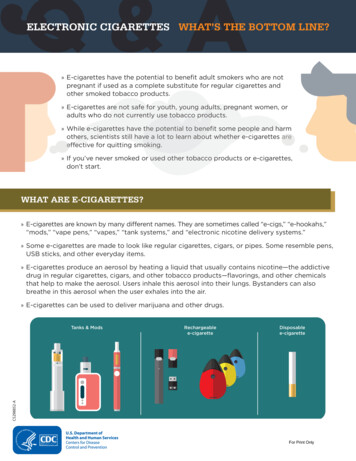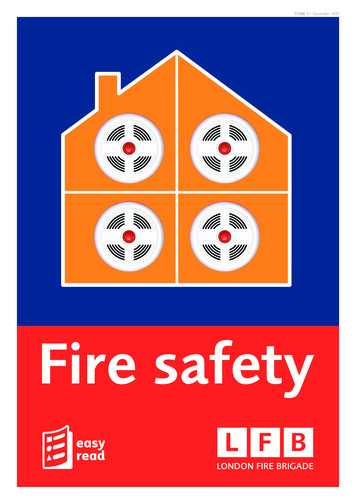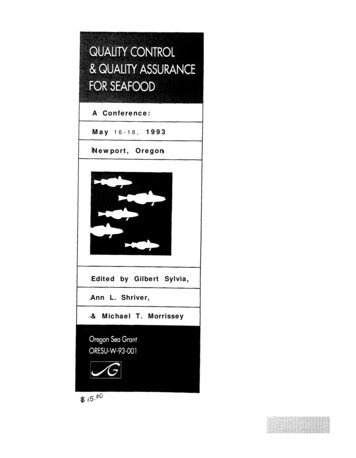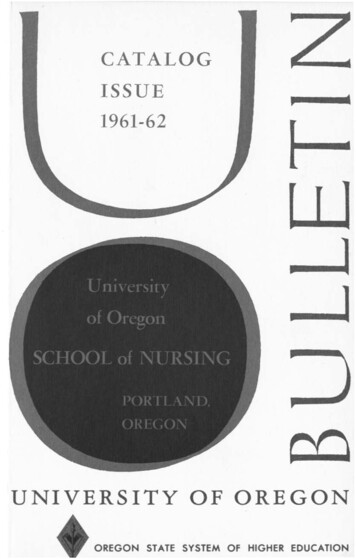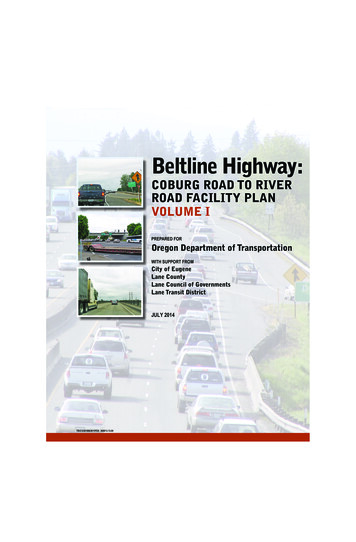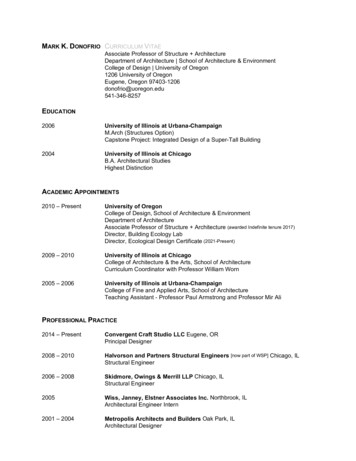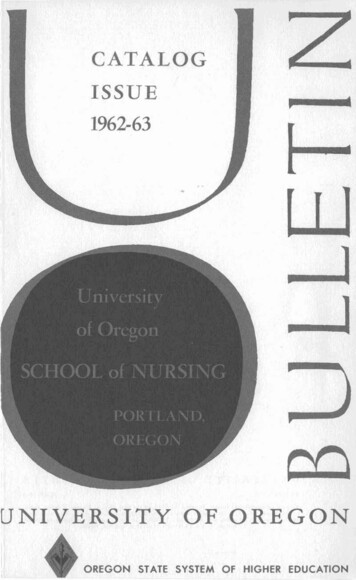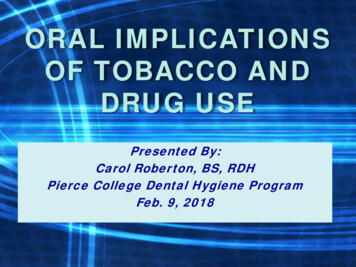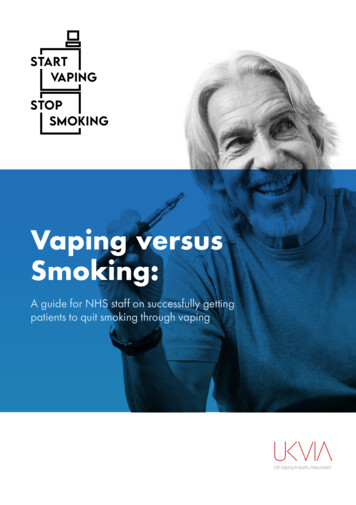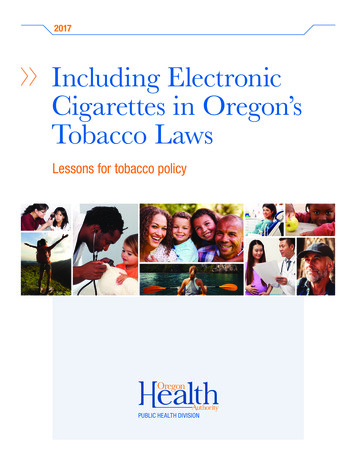
Transcription
2017Including ElectronicCigarettes in Oregon’sTobacco LawsLessons for tobacco policyPUBLIC HEALTH DIVISION
AcknowledgmentsThis report was prepared by Oregon Health AuthorityProgram Design and Evaluation Services, including:Steven Fiala, MPHLinda Drach, MPHThis report was prepared for Oregon Health Authority HealthPromotion and Chronic Disease Prevention Section, including:Karen Girard, MPASarah Hargand, MPHShaun Parkman, MAOversight for the evaluation and resulting report wasprovided by an evaluation advisory group, including:Morgan Cowling, MPAKaren Girard, MPASara Hartstein, MPHRosa Klein, MPPKim La Croix, MPH, RDMichael Tynan, BAFor more information contact:Shaun Parkman, MAEvaluation LeadHealth Promotion and Chronic Disease Prevention SectionOregon Public Health Divisionshaun.w.parkman@state.or.usSuggested reference: Oregon Public Health Division. House Bill 2546: Includingelectronic cigarettes in Oregon’s tobacco laws: lessons for tobacco policy. OregonHealth Authority. Portland, OR. 2017 August.Including Electronic Cigarettes in Oregon’s Tobacco Laws Acknowledgments3
Passing tobacco policy in amodernized public health systemEighty percent of what shapes our health happens outside the doctor’s office. Publichealth promotes the health of all people in Oregon in the places where they live,work, learn and play by working across sectors to advance policy changes thatpromote and support good health.This evaluation sought to characterize one such policy change and harvest lessonsfor future tobacco policy successes. Some ingredients for success identified bythe evaluation also provide vivid illustration of the foundational capabilities of amodern public health system: health equity and cultural responsiveness, leadershipand organizational competencies, emergency preparedness, assessment andepidemiology, communications, policy and planning, and community partnershipdevelopment. State and local public health demonstrate a firm grasp on assessmentand epidemiology in having up-to-date surveillance data on e-cigarette use at-theready, and in conducting assessments of e-cigarette availability in local communities.A solid foundation in communications is evidenced by state public health in meetinglegislators’ requests for timely, high-quality e-cigarette surveillance data, and bylocal public health in providing legislative testimony on local e-cigarette use tocontextualize the policy. Strategic partners, convened by state and local public healthand key legislators, provided testimony on how the policy would be enforced, whichproved essential to passing the strongest possible policy. This community partnershipdevelopment brought new voices to the policy conversation and assisted governmentalpublic health in achieving a collaborative public health goal.Modernized framework for governmental public health lic HealthModernizationFoundationalprograms andcapabilities arepresent at everyhealth isease controlPrevention andhealth promotionEnvironmentalhealthAccess to clinicalpreventative servicesLeadership andorganizational competenciesPolicy and planningHealth equity andcultural responsivenessCommunicationsCommunity partnershipdevelopmentEmergency preparednessand responseAssessment andepidemiology4Passing tobacco policy in a modernized public health system Including Electronic Cigarettes in Oregon’s Tobacco Laws
The foundation for the success of this policy process was built, in part, on years ofcomprehensive tobacco prevention and education in Oregon – 20 years, to be exact.Since 1997, the Oregon Public Health Division’s Tobacco Prevention and EducationProgram has funded and worked with partners in local public health authorities,tribes, regional health equity coalitions, and other community-based and not-forprofit organizations to prevent and reduce tobacco-related deaths in every Oregoncommunity. This tobacco prevention movement continues to implement proventobacco control strategies rooted in surveillance and evaluation, strategic healthcommunications, and community-level interventions with diverse partners.The policy initiative described in this evaluation report is a testament to the efficacyof the comprehensive approach that the Oregon Tobacco Prevention and EducationProgram has been practicing for two decades, and demonstrates how a modernizedpublic health system can amplify its prevention and health promotion work to benefithealth and well-being in Oregon’s ever-changing communities.Including Electronic Cigarettes in Oregon’s Tobacco Laws Passing tobacco policy in a modernized public health system5
Table of contents»»Passing tobacco policy in a modernized public health system. 4»»Executive summary. 8»»Introduction. 16»»Background. 16»»Public health relevance. 16»»Policy evaluation. 17»»Methods. 18»» Figure 1. CDC framework for public health evaluation. 18»»Evaluation advisory group. 19»»Policy process timelines and theory of change model. 19»» Figure 2. Integrated House Bill 2546 timeline. 20»»Evaluation goals and questions. 21»»Evaluation approach. 21»»Stakeholder interview process. 21»»Interview questions. 22»»Analysis approach. 22»»Results. 24»» Part 1: Characterizing the policy process. 24»»Policy process attributes. 24»»Bill attributes. 33»»Bill support reasons. 35»»External factors. 40»»Policy process challenges. 44»»Future concerns. 506Table of contents Including Electronic Cigarettes in Oregon’s Tobacco Laws
»»Part 2: Characterizing the role of state andlocal government and lobbyists. 51»»State government role. 51»»Local government contribution. 53»»Lobbyist contribution. 56»»Tobacco norms and data. 56»»Conclusions. 61»»Applying lessons learned to other Oregon policy processes. 61»»Applying lessons learned for other statesworking on tobacco control. 62»»References. 64»»Appendicies. 66»»Appendix A. Evaluation advisory group members. 66»»Appendix B. State government House Bill 2546 timeline. 67»»Appendix C. Local government House Bill 2546 timeline. 68»»Appendix D. Lobbyists House Bill 2546 timeline . 69»»Appendix F. List of stakeholder interviewees. 70»»Appendix G. Stakeholder interview request template. 71»»Appendix H. Stakeholder interview script . 72»»Appendix I. Stakeholder interview coding scheme . 74Including Electronic Cigarettes in Oregon’s Tobacco Laws Table of contents7
Executive summaryBackgroundOn May 26, 2015, Oregon Governor Kate Brown signed House Bill 2546 into law.In addition to including vaping products in existing tobacco sales to minors laws, thepolicy was considered a success by public health advocates due to the involvementof multi-sectoral partners, the creation of a forward-thinking definition for vapingproducts that considered substances other than nicotine (e.g., marijuana), and theabsence of an exemption to Oregon’s Indoor Clean Air Act for sampling insidevape shops.The Oregon Public Health Division sought to characterize the House Bill 2546policy process and harvest lessons learned for future policy processes in Oregon, aswell as offer a case study for other jurisdictions in the U.S.What did House Bill 2546 do?1. Created definition for e-cigarettes termed “inhalant delivery systems”2. Amended existing laws related to youth tobacco sales and use to equally applyto inhalant delivery systems3. Created broad term “inhalant” to describe aerosol emitted from device4. “Inhalant” definition included “cannabinoids” (i.e., marijuana) and nonnicotine substances5. Included “inhalants” in the Oregon Indoor Clean Air ActWhat did House Bill 2546 not do?1. Did not include Indoor Clean Air Act exemption for indoor sampling ofe-cigarette products2. Did not include component for taxation of e-cigarette products8Executive summary Including Electronic Cigarettes in Oregon’s Tobacco Laws
Evaluation advisory groupThe Public Health Division convened an evaluation advisory group representingstate and local public health departments and public health lobbyists. The advisorygroup identified evaluation questions, selected policy stakeholders for key informantinterviews, and aided in interpretation of evaluation results.Key informant interviews were conducted with 15 policy stakeholders, includingeight legislators and legislative staff, three public health partners, two public healthlobbyists, and two local public health staff.Evaluation questions1. To what extent and effect did state government, local government, andlobbyists collaborate?2. What role did local, state and national tobacco control infrastructure play?3. What role did external factors in the environment play?Data collection and analysisStakeholder interviews were conducted in October and November 2016 usinga standard script. Interviews were recorded with stakeholder permission andtranscribed verbatim. Data management was conducted in NVivo version 11. Twocoders from the evaluation team independently reviewed and coded all interviewtranscripts. Discrepancies in coding were resolved through discussion and consensusbetween the two coders.Including Electronic Cigarettes in Oregon’s Tobacco Laws Executive summary9
Policy process characteristicsSetting clear bill priorities to focus on youthsales and clean air laws (and not tax) allowed forconsistent stakeholder messagesDiverse stakeholder voices in pre-sessionworkgroups and in hearing testimony, includingnon-traditional partners like law enforcement andbuilding managers and owners“2014 legislative session introduced e-cigarettesas a new product to regulate and allowed time toeducate legislators and other stakeholdersBill characteristicsStakeholders highlighted the following components of thebill as important to policy success:“Novel product definition broad enough toaccount for future industry innovations, andresponsive to future federal regulationsInclusion of cannabinoids in“inhalants” definition to prepare forimplementation of recreational marijuanalegalization in OregonNo Indoor Clean Air Act exemption for indoorsampling in vape shopsKeeping taxation separate to focus on lesscomplex issues like youth sales restrictions andstrengthening clean air regulations10Executive summary Including Electronic Cigarettes in Oregon’s Tobacco Laws“The work together betweenthe workgroup memberswas so multidisciplinary,it was inclusive of stategovernment, localgovernment, nonprofit, andcommunity-based folks. Ithink that was a great model.We wanted somethingthat would apply not just tothe current devices but anycrazy thing that somebody’sgoing to come up within the future. as we get into the hairyquestions of taxation, that’sgoing to take us quicklyto questions about harmreduction those are goingto be more difficult watersto navigate.“Effective pre-session workgroup to draft thebill with representation from legislators, state andlocal public health, community partners, and thevape industry“““Legislative leadership in pre-session workgroupand during session, including succession planningfrom the 2014 to 2015 sessionsI work with a lot ofdifferent groups and I’mon a lot of committees.This one was so crazy wellorganized. Sometimes yougo to meetings and say,‘why am I here?’ This wasnever the case.“Stakeholders identified the following components of thepolicy process as keys to success:
Reasons for bill supportRegulating the vape industry as a growingmarket with no consistency or safety standardsLack of research on the healtheffects of e-cigarette use and exposureto secondhand vaporRecreational marijuana legalizationand prohibiting public use of marijuanawas particularly compelling toconservative legislatorsEffect on local ordinances and ensuring statepolicies do not adversely affect strong local policy““External factors affecting thepolicy processStakeholders commented on several external factors thatinformed the policy process:Growing, but diffuse, vape industry provedineffective during legislative session at alleviatingconcerns with product safety; perpetuated theidea that the new industry needed regulationsRecreational marijuana legalization wastop-of-mind for legislators concerned with publicconsumption of marijuana and youth exposure“ they [people responsiblefor enforcement] don’t haveto figure out what’s in thedevice. If you’re using in theprescribed areas then it’sa violation There was a lot of concernabout the legalization ofmarijuana and where it willbe consumed and how it willbe part of our society. Seeingthat this bill will encompassmarijuana, I think gaverelief to Republicans andDemocrats both. an employee of a vapeshop, with no certification,no license, no professionalbackground, would go intoa room in the back andliterally concoct a liquid formand then sell it to a memberof the public to inhale.“Easier enforcement of the Indoor CleanAir Act given the difficulty of distinguishingbetween substances used in e-cigarettes“““Protecting children from e-cigarette initiation,a potential gateway to regular tobacco andlifelong nicotine addiction, and from exposureto secondhand e-cigarette vaporYoung people are mybiggest concern. Hereare young people vaping.They don’t know what’s inthat. There is no long-termempirical evidence as to theeffect of what they’re doing.“Stakeholders highlighted several reasons for bill supportboth personally and for other stakeholders:Including Electronic Cigarettes in Oregon’s Tobacco Laws Executive summary11
While relatively smooth overall, stakeholders identifiedseveral challenges in the policy process:Keeping the Indoor Clean Air Actexemption out of the bill was the most-citedchallenge; vape shop owners said prohibitingindoor product sampling would harm businessand e-cigarette users wanted communal spacesfor product useSmall business arguments from vape shopowners warning that regulating vape businesseswould stifle a new home-grown industry““Health and cessation claims from vape shopowners and e-cigarette users despite absence ofresearch and lack of FDA approvalConservative values of many legislatorshesitant to regulate a growing industry andexpand the role of government in generalAbsence of voluntary organizations thatdid not have national approval to advocatefor the billLack of research on the health effects ofe-cigarette use and secondhand exposure asreasons to wait before regulating the industry12Executive summary Including Electronic Cigarettes in Oregon’s Tobacco Laws“They [e-cigarette users]felt that if they had groupsettings where they cametogether and talked abouttheir nicotine addiction if they are able to vapetogether in a public space, itwould help them. these young companieshave the argument, andI think it’s a decent one,‘well, you regulated us intoa corner before we reallyeven had a chance to findour feet.’They [e-cigarette users]came and provided somevery heartfelt, very realtestimony that e-cigarettesare really helping thembecause they startedsmoking at a very youngage, which we know is theway that nicotine addictionoften happens.“Challenges during thepolicy process“Laws and regulations outside Oregon,including other states that had already regulatede-cigarettes and lack of federal regulations““It was amazing who I sawvaping. I’ve seen little minigenerations come and go on the streets where I sawthem gathering, there werejust too darn many youngpeople smoking the stuff.“Awareness of vaping increased bothfrom media coverage of emerging researchand stakeholders’ experiences with e-cigarettesin daily life
Future concerns from stakeholdersOverstating the health harms of e-cigarettesrelative to regular cigarettes makes any futureharm reduction conversations more difficultStakeholders provided their perspectives on the roles ofstate and local government and lobbyists:“You know what, I give it allto the state. They were verywell organized. I work on alot of groups with the Cityand the State and this wasa very easy process for me.State government role in policy processGeneral gratitude toward the Oregon PublicHealth Division for helping in the processContribution to pre-session workgroup,especially on the new product definitionInformation sharing including public healthsurveillance data and vape industry trackingFunding local programs to assess e-cigarettes incommunities, which increased capacity to providetestimony for local and state policiesLocal government rolePassing strong local policy provided a precedentand reason to pass state-level e-cigarette policieswithout indoor sampling exemptionsProviding testimony at bill hearings in both theHouse and Senate“When you actually go andphotograph these things forsale in real stores, in realcounties, I think that’s verycompelling. So, the morepictures and tangibles likethat, I think goes a long way.“I think we benefited alot from the very stronginvolvement of thecommunity in MultnomahCounty that had alreadystarted down this road.“Backlash from the marijuana community whomay not have been aware that the law prohibits useof marijuana in public, places of employment“““Further regulating vape businesses mayprove difficult given the growing industryis becoming more organized and may havemore lobbying power (concerns related toimplementing a tax or youth-oriented policieslike a flavor ban)When public health comeson as saying ‘thesecigarettes are all bad,’we’re not giving credit topeople who are taking aharm reduction step andthat philosophically is analignment with other publichealth principles aroundsyringe exchange and a lotof other things we do.“A few stakeholders expressed concerns that may be relevantin future policy processes:Including Electronic Cigarettes in Oregon’s Tobacco Laws Executive summary13
Lobbyist roleOn the ground during legislative session,particularly in the Senate to ensure the bill didnot include an indoor sampling exemptionLocal tobacco prevention partner groupparticipation to strategize for sessionWhile stakeholders provided few specifics onthe role of tobacco prevention programs in thepolicy process, they referenced lessons learnedfrom tobacco industry tactics, the history ofclean air laws, a state-developed countermarketing ad, and cited both general trendsand specific data points from public healthsurveillance systems. A long history of tobaccoprevention in Oregon likely contributed tostakeholder knowledge and perceptions.“There’s all sorts ofresearch showing nationallyAmericans, and I believe ittrickles all the way down toOregonians, are just franklydone with smoking inpublic places.“!Lessons learned for Oregonpolicy processes“Pre-session workgroup withrepresentation from all stakeholdergroups, including the industryDiverse partners from multiple sectors inpre-session workgroups and session hearingsClear bill priorities prior to session forconsistent policy messages during sessionStrong local policies offer leverage to advocatefor similarly strong state regulationsState public health access to legislators torespond to information and data requests14Executive summary Including Electronic Cigarettes in Oregon’s Tobacco Laws“[House Bill] 2546 wasthe big mothership weneeded it to actually passand we wanted everythingelse, but it wasn’t going tobe the priority.“Legislative champions withsuccession planningI’ve been in a lot ofworkgroups. This oneworked really well. Howcome? We had a very, verycircumscribed goal.“Stakeholders considered the following bill and policyprocess elements as essential to success:
Lessons learned for othertobacco programs“Involve vape industry representative(s) inearly policy planning to ensure perspectives areunderstood and consideredSupport local jurisdictions in passing strong,exemption-free ordinances to leverage instatewide policy discussionsLeverage recreational marijuanalegalization to garner support from legislatorsCreate a broad product definition to accountfor future industry innovation“Exclude tax component to moderateopposition from e-cigarette users andanti-tax legislatorsFocus on messages related to youth preventionand easier enforcement of clean air laws?We made sure that wepassed what we wantedin Multnomah County first,because we truly believedthat we can enforce andpush good public policy bytaking the reins up here.“Involve non-traditional partners concernedwith easy enforcement of smokefree lawsWe had a lot of advocatesthat were going aroundand talking, and eachwas emphasizing differentaspects of the bill it wasn’tjust always health peoplegoing to talk there werelots of different people whowere supportive of the bill.“Tobacco control advocates in other states could considerthe following lessons learned in their work:For more information on the evaluation, contact:Shaun Parkman, MAEvaluation LeadHealth Promotion and Chronic Disease Prevention SectionOregon Public Health Divisionshaun.w.parkman@state.or.usIncluding Electronic Cigarettes in Oregon’s Tobacco Laws Executive summary15
IntroductionBackgroundOn May 26, 2015, Oregon Governor Kate Brown signed House Bill 2546 into law.The law went into effect upon signage except for Oregon Indoor Clean Air Act(ICAA) requirements which began on January 1, 2016,¹ and rules related to productpackaging and labeling which went into effect on July 1, 2016.² The bill createda legal definition for electronic cigarettes (e-cigarettes) and other vaping productstermed “inhalant delivery systems” rather than including these products into theexisting definition for “tobacco products”.³ The bill also amended existing lawsrelated to the sale of tobacco products to, and use of tobacco products by, minors(those less than 18 years old) so the laws equally apply to inhalant delivery systems.For the purposes of Oregon’s ICAA, the bill defined the term “inhalant” to includeboth nicotine and non-nicotine substances (e.g., marijuana) and included inhalantsin Oregon ICAA prohibitions against use in the workplace and within 10 feet ofall entrances, exits, windows, and air-intake vents.⁴ The law also gave the OregonHealth Authority the responsibility of writing rules and imposing standards for childresistant product packaging, labeling, and packaging that is not attractive to minors.³Public health relevanceThe law was considered a policy success by public health advocates due to: Multi-sectoral involvement of partners in the process, including many nothistorically supportive of tobacco regulations; Creation of a novel, forward-thinking definition for vaping products thatconsidered substances other than nicotine (e.g., marijuana); and Absence of an exemption to Oregon’s ICAA for the purposes of sampling insideinhalant delivery system retailers (i.e., vape shops). Including vaping products in existing tobacco sales to minors laws.The Oregon Public Health Division sought to systematically and comprehensivelycharacterize the House Bill 2546 policy process to harvest lessons learned for futurepolicy processes in Oregon and offer a case study for other jurisdictions in the UnitedStates pursuing similar tobacco policy efforts.16Introduction Including Electronic Cigarettes in Oregon’s Tobacco Laws
Policy evaluationPolicy, systems and environmental change strategies are the foundation ofcomprehensive tobacco prevention and control efforts.⁵ Policies generally operateat the systems level and can be a cost-effective way to create positive changes inthe health of large portions of the population.⁶ Policy evaluation uses a range ofresearch methods to systematically investigate the effectiveness of policy interventions,implementation and processes, and to determine the merit, worth, or value of apolicy to improve the social and economic conditions of different stakeholders.⁶Evaluating successful policy efforts can serve the important purposes of documentingand informing future policies and policy processes, informing an evidence base forsuccessful policy strategies, and providing accountability for resources invested intobacco prevention and control.⁶Including Electronic Cigarettes in Oregon’s Tobacco Laws Introduction17
MethodsThe Centers for Disease Control and Prevention (CDC) provide a framework forpublic health evaluation that emphasizes stakeholder engagement to describe theprogram or process of interest; determine the most appropriate evaluation design anddata collection methods; aid in results interpretation; and ensure appropriate sharing oflessons learned (Figure 1). The CDC evaluation framework guided this policy processevaluation, which began by convening an evaluation advisory group. Evaluationmethods are detailed below, including the role of the evaluation advisory group.Figure 1. CDC framework for public health racyGatherCredibleEvidenceMethods Including Electronic Cigarettes in Oregon’s Tobacco LawsFal o c u suatio ntify nsJ u s usiolConc18En gag eS t ake ho l d e r sther ib esc ramD e P rogUseaLes nd ShLea sons ar nedreEv
Evaluation advisory groupThe evaluation advisory group consisted of six individuals, including four OregonPublic Health Division staff, one local public health department staff member, andone lobbyist for county public health departments (a list of advisory group membersis in Appendix A). The composition of the advisory group was chosen to representthe three key stakeholder groups involved in the policy process, including statepublic health, local public health, and lobbyists. All advisory group members hadparticipated in the policy process under evaluation.The advisory group was tasked with the following activities: (1) developing a timelineof the policy process and theory of change model; (2) identifying the evaluation goalsand evaluation questions; (3) informing data collection methods, including selection ofstakeholder interviewees; and (4) aiding in interpretation of evaluation results.Policy process timelines and theory of change modelThe first objective of the advisory group was to jointly create a timeline of events inthe policy process from the perspectives of state and local public health and lobbyists.The creation of a timeline from the perspectives of advisory group members helpedbuild a shared understanding of the process and identify the unique contributionsof each stakeholder type. These timelines would later inform the development ofevaluation questions and data collection methods, as well as results interpretationand reporting. The timelines would also be used after data collection and analysisto highlight converging and diverging external stakeholder perceptions of the policyprocess. Based on the timelines, a theory of change model was also created to visuallydepict the conditions that were in place to achieve the outcome of policy passage.An integrated timeline is presented as Figure 2, individual timelines for state publichealth, local public health, and lobbyists are presented as Appendices B-D, and thetheory of change model is presented as Appendix E.Including Electronic Cigarettes in Oregon’s Tobacco Laws Methods19
Figure 2. Integrated House Bill 2546 timeline20Methods Including Electronic Cigarettes in Oregon’s Tobacco Laws
Evaluation goals and questionsThe advisory group identified two high-level evaluation goals: (1) document strengthsand areas for improvement for the Public Health Division’s role in policy processes; and(2) describe the policy process and lessons learned for other jurisdictions interested insimilar tobacco prevention policies.Based on the policy process timelines and evaluation goals, the advisory groupdeveloped and prioritized the following evaluation questions:1. To what extent and effect did state government, local government, and lobbyistscollaborate in the policy process?2. What role did local, state, and national tobacco control infrastructure play in thepolicy process?3. What role did e
In addition to including vaping products in existing tobacco sales to minors laws, the policy was considered a success by public health advocates due to the involvement of multi-sectoral partners, the creation of a forward-thinking definition for vaping products that considered
